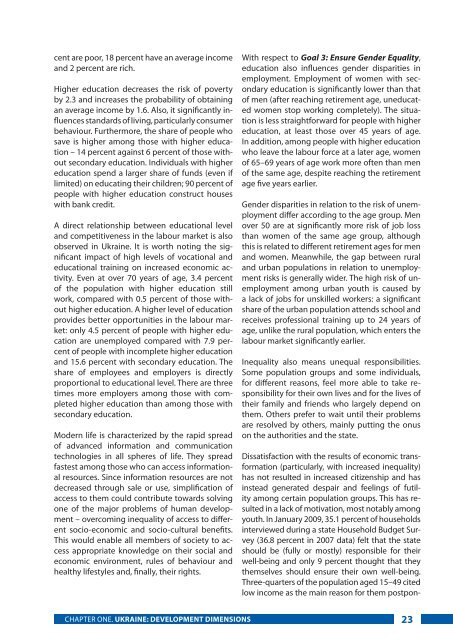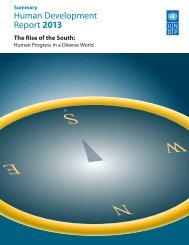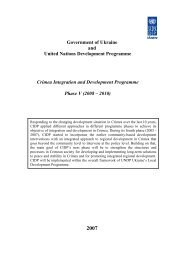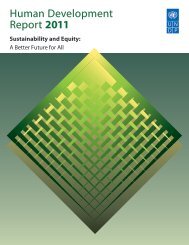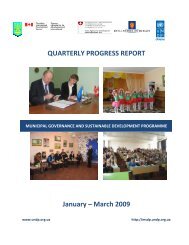Inequality as an Obstacleto Achiev<strong>in</strong>g the MDGsS<strong>in</strong>ce Ukra<strong>in</strong>e achieved <strong>in</strong>dependence <strong>in</strong> 1991,its previously egalitarian society has been characterizedby very high levels of <strong>in</strong>equality, whichrelates to <strong>in</strong>comes, access to basic social services(<strong>in</strong>formation, communications, education, healthcare, social services, etc), health status, life expectancy,liv<strong>in</strong>g conditions and quality of life andthe access to labour market.The modern <strong>in</strong>terpretation of <strong>in</strong>equality assumesexclusion along not only economic but also social,political and ethno-cultural l<strong>in</strong>es. Differentgroups of the population can suffer from particulartypes of <strong>in</strong>equality as a result of violations oftheir rights; however, the most critical is a comb<strong>in</strong>ationof several types of <strong>in</strong>equality. Extremelynegative and threaten<strong>in</strong>g phenomena, such asexclusion of population groups from public life(social exclusion), polarization and marg<strong>in</strong>alization,occur as a result of the cumulative impactsof different types of <strong>in</strong>equality.With<strong>in</strong> the context of the MDGs, the most obviousform of <strong>in</strong>equality relates to Goal 1: ReducePoverty, namely, <strong>in</strong>come <strong>in</strong>equality, which is reflectedby the existence of poor and rich groups<strong>in</strong> the population. Income <strong>in</strong>equality deepens <strong>in</strong>equality<strong>in</strong> relation to access to key social services(quality health care, education and hous<strong>in</strong>g) andresources (f<strong>in</strong>ancial, particularly credit, land, etc)and to the exercise of fundamental rights <strong>in</strong> general(rights to health, life and security). At the sametime, <strong>in</strong>come <strong>in</strong>equality itself is a consequence ofother types of <strong>in</strong>equality. In particular, childrenfrom poor families, who do not have sufficient accessto quality education, more often live belowthe poverty l<strong>in</strong>e. Meanwhile, a significant numberof those with higher education do not work <strong>in</strong>their area of specialization or work <strong>in</strong> unskilledjobs. From 1999, a stable direct correlation hasbeen observed between education and <strong>in</strong>comelevels. This <strong>in</strong>cludes <strong>in</strong>equality <strong>in</strong> life expectancyow<strong>in</strong>g to an <strong>in</strong>ability to ma<strong>in</strong>ta<strong>in</strong> a healthy lifestyle,lack of access to quality health care servicesand lack of a clean environment. Consequently,children from poor families have a higher risk ofpremature death or illness and fewer opportunitiesto realize their potential.High <strong>in</strong>equality and poverty levels cause socialtension and conflicts and <strong>in</strong>creases <strong>in</strong> crime. Theconsequences of these, particularly under conditionsof political <strong>in</strong>stability, are an <strong>in</strong>crease <strong>in</strong>economic risks and decreased attractiveness ofthe country’s <strong>in</strong>vestment environment. This <strong>in</strong>evitablyslows down economic growth. On theother hand, <strong>in</strong>equality is an <strong>in</strong>dicator not only ofcrim<strong>in</strong>alization but also of corruption. Economic<strong>in</strong>equality is a barrier to democratic reforms.Income <strong>in</strong>equality often causes macroeconomic<strong>in</strong>stability. Significant <strong>in</strong>equality <strong>in</strong> the populationis a factor of poverty, and requires a large-scalesecondary redistribution of <strong>in</strong>come through socialtransfers which, other th<strong>in</strong>gs be<strong>in</strong>g equal, could affectthe budget deficit and also <strong>in</strong>flation (which affectsthe <strong>in</strong>come of poor groups of the populationmore strongly, exacerbat<strong>in</strong>g <strong>in</strong>equality).Economic buoyancy caused significant – andquite positive – structural changes <strong>in</strong> terms of <strong>in</strong>equalitywith<strong>in</strong> the population: wage <strong>in</strong>come has<strong>in</strong>creased notably (from 20.9 percent <strong>in</strong> 1999 to41.6 percent <strong>in</strong> 2008), as has <strong>in</strong>come from entrepreneurialactivities (from 2.4 percent to 7.9 percent).At the same time, <strong>in</strong>come from unregisteredeconomic activities, which reached 42.6 percentat transition, (more than wages, pensions and <strong>in</strong>comefrom private subsidiary plots comb<strong>in</strong>ed), iscurrently at only 17.9 percent. The importance of<strong>in</strong>come from private subsidiary plots has not onlysignificantly decreased but also now counters <strong>in</strong>equality,s<strong>in</strong>ce these rema<strong>in</strong> a source of <strong>in</strong>comepredom<strong>in</strong>antly for the poor population. The <strong>in</strong>comesof the poor have approached those of theaverage population. However, the economic crisisof 2008 to 2009 had an impact on these structuralchanges.Inequality <strong>in</strong> the context of Goal 2: EnsureQuality Lifelong Education deserves special attention.Quality education can be a major cushionaga<strong>in</strong>st shocks and, at the same time, is an extremelyimportant factor <strong>in</strong> economic <strong>in</strong>equality.At present, socio-economic status is closely relatedto educational level <strong>in</strong> Ukra<strong>in</strong>e: among peoplewho have completed higher education, 11 percentare poor, 35 percent have an average <strong>in</strong>comeand 7.5 percent are rich; among those who havecompleted only general secondary education (i.e.without systematic professional tra<strong>in</strong><strong>in</strong>g), 29 per-22<strong>MILLENNIUM</strong> <strong>DEVELOPMENT</strong> <strong>GOALS</strong>. UKRAINE – 2010
cent are poor, 18 percent have an average <strong>in</strong>comeand 2 percent are rich.Higher education decreases the risk of povertyby 2.3 and <strong>in</strong>creases the probability of obta<strong>in</strong><strong>in</strong>gan average <strong>in</strong>come by 1.6. Also, it significantly <strong>in</strong>fluencesstandards of liv<strong>in</strong>g, particularly consumerbehaviour. Furthermore, the share of people whosave is higher among those with higher education– 14 percent aga<strong>in</strong>st 6 percent of those withoutsecondary education. Individuals with highereducation spend a larger share of funds (even iflimited) on educat<strong>in</strong>g their children; 90 percent ofpeople with higher education construct houseswith bank credit.A direct relationship between educational leveland competitiveness <strong>in</strong> the labour market is alsoobserved <strong>in</strong> Ukra<strong>in</strong>e. It is worth not<strong>in</strong>g the significantimpact of high levels of vocational andeducational tra<strong>in</strong><strong>in</strong>g on <strong>in</strong>creased economic activity.Even at over 70 years of age, 3.4 percentof the population with higher education stillwork, compared with 0.5 percent of those withouthigher education. A higher level of educationprovides better opportunities <strong>in</strong> the labour market:only 4.5 percent of people with higher educationare unemployed compared with 7.9 percentof people with <strong>in</strong>complete higher educationand 15.6 percent with secondary education. Theshare of employees and employers is directlyproportional to educational level. There are threetimes more employers among those with completedhigher education than among those withsecondary education.Modern life is characterized by the rapid spreadof advanced <strong>in</strong>formation and communicationtechnologies <strong>in</strong> all spheres of life. They spreadfastest among those who can access <strong>in</strong>formationalresources. S<strong>in</strong>ce <strong>in</strong>formation resources are notdecreased through sale or use, simplification ofaccess to them could contribute towards solv<strong>in</strong>gone of the major problems of human development– overcom<strong>in</strong>g <strong>in</strong>equality of access to differentsocio-economic and socio-cultural benefits.This would enable all members of society to accessappropriate knowledge on their social andeconomic environment, rules of behaviour andhealthy lifestyles and, f<strong>in</strong>ally, their rights.With respect to Goal 3: Ensure Gender Equality,education also <strong>in</strong>fluences gender disparities <strong>in</strong>employment. Employment of women with secondaryeducation is significantly lower than thatof men (after reach<strong>in</strong>g retirement age, uneducatedwomen stop work<strong>in</strong>g completely). The situationis less straightforward for people with highereducation, at least those over 45 years of age.In addition, among people with higher educationwho leave the labour force at a later age, womenof 65–69 years of age work more often than menof the same age, despite reach<strong>in</strong>g the retirementage five years earlier.Gender disparities <strong>in</strong> relation to the risk of unemploymentdiffer accord<strong>in</strong>g to the age group. Menover 50 are at significantly more risk of job lossthan women of the same age group, althoughthis is related to different retirement ages for menand women. Meanwhile, the gap between ruraland urban populations <strong>in</strong> relation to unemploymentrisks is generally wider. The high risk of unemploymentamong urban youth is caused bya lack of jobs for unskilled workers: a significantshare of the urban population attends school andreceives professional tra<strong>in</strong><strong>in</strong>g up to 24 years ofage, unlike the rural population, which enters thelabour market significantly earlier.Inequality also means unequal responsibilities.Some population groups and some <strong>in</strong>dividuals,for different reasons, feel more able to take responsibilityfor their own lives and for the lives oftheir family and friends who largely depend onthem. Others prefer to wait until their problemsare resolved by others, ma<strong>in</strong>ly putt<strong>in</strong>g the onuson the authorities and the state.Dissatisfaction with the results of economic transformation(particularly, with <strong>in</strong>creased <strong>in</strong>equality)has not resulted <strong>in</strong> <strong>in</strong>creased citizenship and has<strong>in</strong>stead generated despair and feel<strong>in</strong>gs of futilityamong certa<strong>in</strong> population groups. This has resulted<strong>in</strong> a lack of motivation, most notably amongyouth. In January 2009, 35.1 percent of households<strong>in</strong>terviewed dur<strong>in</strong>g a state Household Budget Survey(36.8 percent <strong>in</strong> 2007 data) felt that the stateshould be (fully or mostly) responsible for theirwell-be<strong>in</strong>g and only 9 percent thought that theythemselves should ensure their own well-be<strong>in</strong>g.Three-quarters of the population aged 15–49 citedlow <strong>in</strong>come as the ma<strong>in</strong> reason for them postpon-CHAPTER ONE. UKRAINE: <strong>DEVELOPMENT</strong> DIMENSIONS 23


